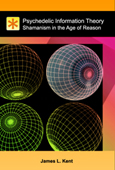
Search Results : memory
Showing 20 to 40 of 42
... line, contrast, and texture detail in visual memory. This can be described as a rendering ambiguity error, and indicates a drifting of contrast information both laterally and radially across the cortex. This drifting in the visual field is most ...
... and can also generate false memories; lost memory reconsolidation and false memory imprinting implies neuroplasticity. The brain builds tolerance to psychedelics quickly, but psychedelic tolerance can be surpassed by successively ingesting lar...
An Overview of Physical Shamanism
... salient recognition and imprints itself into memory according to the sustain and release. As the interrupt’s ADSR envelope begins to influence multisensory perception, spirit information will appear to overlap onto the fabric of reality; bendi...
... more fully formed images that appear from visual memory or imagination. Psychedelic eidetic hallucinations are generally more explicitly personal than the abstract geometric forms associated with flicker phosphenes. Over the course of a psychedelic ...
... (homeostatic regulator), hippocampus (memory and learning), and neocortex (sensory and logic processing). Neuromodulators synchronize the neural response to incoming stimulus and keep local competing brain circuits functioning smoothly an...
The Value of Psychedelic Information
... by psychedelics. Psychedelics target perception, memory, and the complex emotions attached to symbols and concepts; the core functions humans rely on to formulate belief. Because of this exploit, the result of the psychedelic catalyst in humans is t...
... are Alzheimer's disease, which effects memory, and schizophrenia, which affects coherence and linear stability. These two examples compress a much larger discussion of how the degradation or loss of specific functions and operating propert...
... synaptic bonding, emotional imprinting, and memory....
... system are: 1) perception; 2) recognition; 3) memory; 4) recall; and 5) behavior. The minimum specific operating properties for any conscious system are: 1) modular coherence; 2) linear stability; 3) feedback control; 4) adaptability; and 5) self...
... psychedelic sessions can create blank spots in memory where the user is awake and active but has no control or memory of their behaviors. When people lose control in a psychedelic trip it is typically because they have taken too large a dose. High...
Psychedelic Information Theory
... emotions; the collective unconscious; genetic memory; spirit entities; alien transmission; junk data from neural excitation; and so on. Regardless of the origin it is widely accepted that psychedelics do generate information, and not merely junk ...
The Dream Drugstore: Chemically Altered States of Consciousness
... 4: In order for information to be stored in memory the serotonergically modulated forebrain must be online and queuing information into the medial temporal lobe for storage. If the brain is hallucinating that means memory is modulated by acetyl...
What is Psychedelic Information Theory?
... neural signaling as they apply to perception, memory, and consciousness; this also makes PIT a text on multidisciplinary neuroscience.Why Psychedelic Information Theory? The bulk of human consciousness exists in a linear range which goes from h...
Scientists explain inception of perception in the brain
... to understanding not only perception, but memory, language, cognition." Barry Connors, chair of the Department of Neuroscience and the senior scientist on the project, said the findings may also shed light on the causes of some forms of ep...
How the Brain Filters out Distracting Thoughts to Focus on a Single Bit of Information
... with all kinds of information, from the memory of last night's delicious dinner to the instructions from your boss at your morning meeting. But how do you "tune in" to just one thought or idea and ignore all the rest of what is going on aro...
Frequency of gamma oscillations routes flow of information in the hippocampus
... as perception1, 2, 3, attentional selection4 and memory5, 6. This 'binding' mechanism requires that spatially distributed cells fire together with millisecond range precision7, 8; however, it is not clear how such coordinated timing is achieved give...
... implies holistic or meta level manipulation of memory and identity, and so this definition fulfills the functions of therapy, sorcery, mind control, applied psychedelic science, targeted neuroplasticity, behavioral conditioning, and tribal bonding...
Cortical Region Interactions and the Functional Role of Apical Dendrites
The basal and distal apical dendrites ofpyramidal cells occupy distinct cortical layers and are targeted by axons originating in different cortical regions. Hence, apical and basal dendrites receive information from distinct sources. Physiological ev...
Presynaptic regulation of recurrent excitation by D1 receptors in prefrontal circuits
... cortex plays a fundamental role in the working memory functions of the cerebral cortex and is also the site of dysfunction in several neurological and psychiatric disorders, including schizophrenia. Prefrontal neurons are distinguished by their ca...
Timewarp: How your brain creates the fourth dimension
... or whether the slo-mo is just an artefact of our memory. It's just one of many mysteries concerning how we experience time that we are only now beginning to crack. "Time," says Eagleman, "is much weirder than we think it is." By understanding ...
« Back 20 | Next 20 » Showing 20 to 40 of 42
